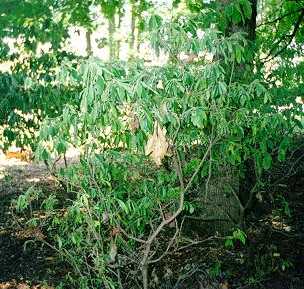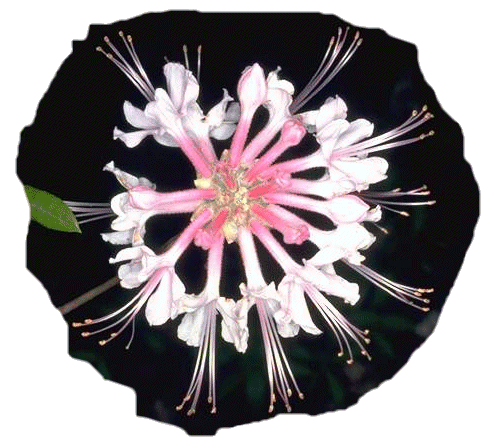
| 
|
Binita Patel, State Botanical Gardens of Georgia Scanned by: Elizabeth Skillen |
Courtesy, The University of Georgia Herbarium
Scanned by: Elizabeth Skillen |
AUTHOR: Binita S. Patel
Common Names: (Brako, Farr, and Rossman, 1995)
- Piedmont azalea
- Sweet florida pinxter
- Native azalea
- Hoary azalea
- Wild honeysuckle
Higher Taxon: (Hyan and Pankhurst, 1995)
- Class: Dicotyledoneae
- Order: Ericacles
- Family: Ericaceae
- Genus: Rhododendron
- Sub- genus: Azalea
- Species : Canescens
Discovery of the R. Canescens:
During the late 1780s, a French botanist by the name of Andre Michaux went to North America to collect plants for the depleted forest, Rambouillet, southwest of Paris. There he identified the species Rhododendron canescens in what is now the Southeastern United States. On Michaux's return to Paris, he shipwrecked and lost most of his collection (Esposito, 1994). The location of many of his collection is the Natural History Museum in Paris (Stafleu and Cowan, 1981). It is unknown if this specie is displayed there. (Patel, 1998).
Description:
This deciduous shrub is an upright-growing native plant, which grows to 3m tall. The description of the piedmont azalea is best described as the following by Ahles, Bell, and Radford, "Leaves elliptic to oblanceolate, 1.5-4 cm wide, 3-9cm long entire to ciliate-serrulate, obtuse to acute with a prominent mucro, base cuneate, finely pubescent above, densely canscent beneath and often with a few longer and stouter trichomes along the midrib; petioles 2-10 mm long. Pedicels canescent and stipitate-glandular. Calyx lobes 0.5-1 mm long; corolla tube canescent and stipitate-glandular on the outside, 1.5-2.5 cm long slender, abruptly expanded at top, lobes spreading, light to deep pink, the largest lobe often with yellow in the center, 1-2 cm long, margins undulate, acute; stamens 5, almost 1.3x as long as the corolla; pistil equaling or exceeding stamens. Capsule densely canescent often with a few longer trichomes, stipitate glands absent, 1.4-1.7 cm long" (Ahles, Bell, and Radford, 1964).
Geography:
Native to the Southeast, the Rhododendron canescens are widespread through out ranging from Virginia to Mississippi, up through Kentucky to West Virginia (Ahles, Bell, and Radford, 1964)
Table 1: North American Distribution of Rhododendron Canescens
|
Rhododendron Canescens |
|
AREA |
STATUS |
REFERENCES |
|
North America: Continental United States: Canada |
YES |
|
|
Eastern North America: United States east of Mississippi; Ontario and eastern Canada |
YES |
|
|
Southeastern United States: AL AR DE DC FL GA KY MD NC SC TN VA WV |
YES |
|
|
Southern Appalachian States: AL GA KY MD NC SC TN VA WV |
YES |
|
|
Coastal Plain |
YES |
|
|
Piedmont |
YES |
|
|
Blue Ridge Mountains |
YES |
|
|
Great Smokey Mountain National Park |
YES |
|
| Ridge and Valley |
YES |
|
|
Cumberland Plateau |
YES |
|
|
Central Arch |
? |
- |
|
Georgia |
YES |
|
|
Clarke County, Georgia |
YES |
|
|
Sams Farm |
PROBABLY |
Binita Patel, 1998 (Guess) |
|
Old Field |
? |
Binita Patel, 1998 (Guess) |
|
Wetland |
PROBABLY |
Binita Patel, 1998 (Guess) |
|
Woods |
PROBABLY |
Binita Patel, 1998 (Guess) |
|
1-Hectare Plot |
PROBABLY |
Binita Patel, 1998 (Guess) |
How to Encounter:
The species, Rhododendron canescens, can be found growing along river and stream banks, woodlands, rocky open woodlands, and pine flatwoods (Godfrey & Wooten, 1981). Also we may discover them in well drained moist wooded slopes, pocosins, savannas, and some swamp forests (Radford, 1964). The R. canscens, a native ornamental flower, is used for adding a splash of color to natural borders. During the springtime, these pink and white blooms appear at the State Botanical Gardens of Georgia in Athens, GA. Piedmont azaleas are available at commercial nurseries for cultivation.
Natural History:
This species, an oranmental flower (Knopf, 1979), grows best in moist acidic soil, pH ranging from 5.0 to 6.0, and filtered light is best (Fryling, Odenwald, and Pope,1996). Also insect pests such as root rot, spider mites, and aphids or fungal infections, dieback, and petal blight, can cause damage to the buds of the R. Canescens (Fryling, Odenwald, and Pope, 1996). In particular, the bud boring cutworm has caused great damage to the R. Canescens in Alabama. The cutworm, Peridroma saucia, feeds upon the buds of the canescens. Some of the buds shrivel up and die, while others produce incomplete blooms (Hyche, 1998).
Image one displays the full bloom. Image two shows the incomplete bloom
Image 1: R. Canescens
Image 2: R. Canescens
Image 1&2, Courtesy of Lacy Hyche, Auburn University
For additional information concerning the damage caused by the cutworm, link to http://www.ag.auburn.edu/dept/ent/bulletins/cutworm.htm
This web page designed by Binita Patel (
bpatel@arches.uga.edu or bpatel@dial.pick.uga.edu)
![]()

